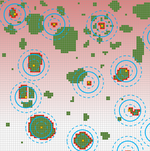Abstract
-
Species distribution models (SDMs) are algorithms designed to infer the distribution of species using environmental and biotic variables and have become an important tool for ecologists and conservation biologists seeking to understand the implications of environmental change.
-
Global datasets of environmental variables at resolutions of a few metres are increasingly available. SDMs fitted using such high-resolution data allow researchers to investigate how local factors affect species occurrences at unprecedented fine spatial scales.
-
As the spatial resolution of SDMs increases, we see a critical need to consider the characteristics of habitat types within or around raster pixels. In particular, we argue that the effects of habitat patches (EHPs, including habitat area, habitat configuration, and habitat diversity), measured focusing on patches or landscapes, have yet to be fully realized in SDMs.
-
We provide guidelines to incorporate EHPs in SDMs. We explain why this development is important, describe approaches to properly conduct such analyses, and discuss pitfalls we foresee in testing EHPs.
-
Synthesis. Ensuring that SDMs incorporating EHPs are properly designed will be key to increasing model predictive performance and to understanding which environmental factors influence the distribution of species at fine spatial scales. At a crucial time for nature conservation, we foresee that this will be a key step forward to understanding and protecting biodiversity.
